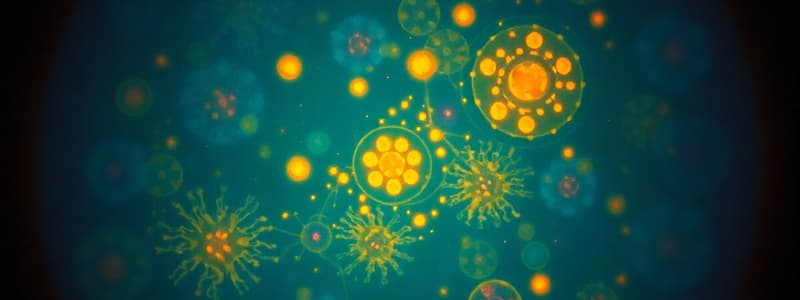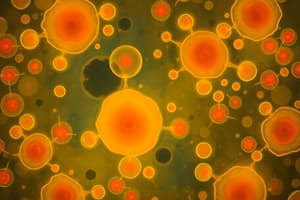Podcast
Questions and Answers
What is the largest organelle in the cytoplasm?
What is the largest organelle in the cytoplasm?
nucleus
Which of the following statements about the cytoplasm is true? (Select all that apply)
Which of the following statements about the cytoplasm is true? (Select all that apply)
- It contains organelles (correct)
- It has a solid structure
- It is a gel-like medium called cytosol (correct)
- It provides structural support for the cell (correct)
All eukaryotic cells start life with a nucleus.
All eukaryotic cells start life with a nucleus.
True (A)
What is the role of the nuclear envelope?
What is the role of the nuclear envelope?
What is chromatin?
What is chromatin?
What are the two types of chromatin? (Select all that apply)
What are the two types of chromatin? (Select all that apply)
What is the shape of mitochondria most often described as?
What is the shape of mitochondria most often described as?
Flashcards are hidden until you start studying
Study Notes
The Cytoplasm
- The cytoplasm encompasses a variety of organelles, many enclosed by membranes.
- The nucleus, the largest organelle, is enveloped by a membrane system known as the nuclear envelope.
- The nucleus houses the cell's genetic material in the form of deoxyribonucleic acid (DNA).
- The endoplasmic reticulum, an elaborate network of flattened membrane-bound tubules, saccules, and cisterns, is dispersed throughout the cytoplasm.
- The Golgi apparatus, a distinct system of membrane-bound saccules, is typically positioned near the nucleus.
- Mitochondria, elongated organelles with a smooth outer membrane and a convoluted inner membrane system, are scattered freely within the cytoplasm.
- In addition to these primary organelles, the cell comprises other membrane-bound structures, including intracellular transport vesicles and lysosomes.
- The cytoplasmic organelles are suspended in a gel-like medium called cytosol, where numerous metabolic reactions occur.
- Embedded within the cytosol is a network of tiny tubules and filaments collectively termed the cytoskeleton, which provides structural support for the cell and its organelles. The cytoskeleton also facilitates the transfer of materials within the cell and the movement of the cell itself.
- Membranes create distinct compartments within the cell, each with its unique biochemical environment.
- Membranes therefore serve to separate incompatible biochemical and physiological processes.
- Enzyme systems are anchored to membranes, making membranes themselves the sites of numerous specific biochemical reactions.
- All eukaryotic cells begin life with a nucleus.
The Nucleus
- The nucleus is a double-membraned sac that holds the eukaryotic cell's DNA.
- The nuclear envelope is a pore-riddled double membrane that controls the entry and exit of substances into and out of the nucleus.
- Nucleoplasm is the semifluid interior portion of the nucleus.
- The nucleolus is a rounded mass of proteins and copies of genes for ribosomal RNA used in the construction of ribosomal subunits. These subunits pass through nuclear pores into the cytoplasm, where they join and become active in protein synthesis.
- Chromatin refers to the entire collection of all DNA molecules and associated proteins in the nucleus, encompassing all the cell's chromosomes.
- A chromosome is composed of one DNA molecule and many associated proteins.
Chromosomes
- Chromatin is the collective term for all DNA molecules and their associated proteins within the nucleus.
- The genetic material is distributed among a specific number of DNA molecules.
- The number of DNA molecules is characteristic of the organism and cell type but varies widely among species.
Chromatin
- Heterochromatin appears as aggregated coarse granules in electron microscopy (EM) and as basophilic clumps in light microscopy (LM). It is condensed chromatin.
- Euchromatin appears as finely dispersed granular materials in EM and as lightly stained basophilic areas in LM. It is extended, uncoiled chromatin.
Mitochondria
- Mitochondria vary considerably in size and shape and change shape over time, often appearing as elongated, sausage-shaped organelles.
- Mitochondria are highly mobile and move around the cell via microtubules.
- They tend to...
Studying That Suits You
Use AI to generate personalized quizzes and flashcards to suit your learning preferences.




